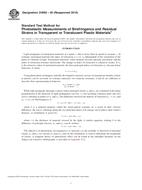Potrebujeme váš súhlas na využitie jednotlivých dát, aby sa vám okrem iného mohli ukazovať informácie týkajúce sa vašich záujmov. Súhlas udelíte kliknutím na tlačidlo „OK“.
ASTM D4093-95(2010)
Standard Test Method for Photoelastic Measurements of Birefringence and Residual Strains in Transparent or Translucent Plastic Materials
Automaticky preložený názov:
Štandardná skúšobná metóda pre fotoelastického meranie dvojlomu a zostatkovej deformácie v priehľadné alebo priesvitné plastové materiály
NORMA vydaná dňa 1.11.2010
Informácie o norme:
Označenie normy: ASTM D4093-95(2010)
Poznámka: NEPLATNÁ
Dátum vydania normy: 1.11.2010
Kód tovaru: NS-26006
Počet strán: 11
Približná hmotnosť: 33 g (0.07 libier)
Krajina: Americká technická norma
Kategória: Technické normy ASTM
Anotácia textu normy ASTM D4093-95(2010) :
Keywords:
birefringence, photoelastic measurements, photoelastic retardation, strain, strain-optical constant, transparent plastics, Birefringence, Color--plastics, Deformation--plastics, Light transmission and reflection, Photoelastic measurement, Plastic sheet and film, Polariscopic examination, Reflectance and reflectivity, Refractive index, Residual strains, Retardation, Strain testing--plastics, Stress--plastics, Transparent plastics, ICS Number Code 83.080.01 (Plastics in general)
Doplňujúce informácie
| Significance and Use | ||||||||||
|
The observation and measurement of strains in transparent or translucent materials is extensively used in various modeling techniques of experimental stress analysis. Internal strains induced in manufacturing processes such as casting, molding, welding, extrusion, and polymer stretching can be assessed and part exhibiting excessive strains identified. Such measurements can lead to elimination of defective parts, process improvement, control of annealing operation, etc. When testing for physical properties, polariscopic examination of specimens is required, to eliminate those specimens exhibiting abnormal internal strain level (or defects). For example: Test Methods D638 (Note 8) and D882 (Note 11) recommend a polariscopic examination. The birefringence of oriented polymers can be related to orientation, shrinkage, etc. The measurements of birefringence aid in characterization of these polymers. For many materials, there may be a specification that requires the use of this test method, but with some procedural modifications that take precedence when adhering to the specification. Therefore, it is advisable to refer to that material specification before using this test method. Table 1 of Classification System D4000 lists the ASTM materials standards that currently exist. |
||||||||||
| 1. Scope | ||||||||||
|
1.1 This test method covers measurements of direction ofprincipal strains, ε1 and ε2, and the photoelastic retardation, δ, using a compensator, for the purpose of analyzing strains in transparent or translucent plastic materials. This test method can be used to measure birefringence and to determine the difference of principal strains or normal strains when the principal directions do not change substantially within the light path. 1.2 In addition to the method using a compensator described in this test method, other methods are in use, such as the goniometric method (using rotation of the analyzer) mostly applied for measuring small retardation, and expressing it as a fraction of a wavelength. Nonvisual methods employing spectrophotometric measurements and eliminating the human judgment factor are also possible. 1.3 Test data obtained by this test method is relevant and appropriate for use in engineering design. 1.4 The values stated in either SI units or inch-pound units are to be regarded as standard. The values stated in each system may not be exact equivalents; therefore, each system shall be used independently of the other. Combining values from the two systems may result in nonconformance with the standard. 1.5 This standard does not purport to address all of the safety concerns, if any, associated with its use. It is the responsibility of the user of this standard to establish appropriate safety and health practices and determine the applicability of regulatory limitations prior to use. Note 1—There is no known ISO equivalent to this test method. |
||||||||||
| 2. Referenced Documents | ||||||||||
|



 Cookies
Cookies
